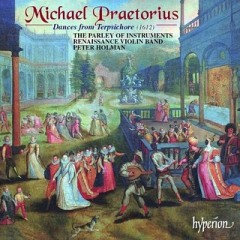Michael Praetorius - Dances from Terpsichore (2001)
Michael Praetorius - Dances from Terpsichore (2001)

1. Passameze, for 5 part instrumental ensemble (283) 2. Gaillarde, for 5 part instrumental ensemble (284) 3. Gaillarde, for 5 part instrumental ensemble (285) 4. Bransles, for 5 part instrumental ensemble (1) 5. Est ce Mars, for 4 lutes 6. Courante de Mars, for 4 lutes 7. Ballet, for four lutes 8. Ballet, for four lutes 9. Un jour de la semaine, for 4 lutes 10. Allons aux noces, for 4 lutes 11. Gaillarde, for 4 lutes 12. Pavane de Spaigne, for 4 part instrumental ensemble (Terpsichore, 30) 13. Spagnoletta (Terpischore, 27) 14. La Sarabande, for ensemble (Terpischore, 34) 15. La Canarie (Terpischore, 31) 16. Branse Simple, for 5 part instrumental ensemble (4) 17. Ballet, for 4 part instrumental ensemble (268) 18. Ballet du Roy pour sonner apres (Terpischore, 269) 19. Ballo del Gran Duca (from Novus Partus) 20. Une jeune fillette (from Novus partus) 21. Bransles de Villages 22. Bransles de Villages, for 5 part instrumental ensemble (Terpsichore, 14) 23. Courante (Wilson's Wild), for violin, 2 violas, bass violin & 4 lutes (Terpsichore, 151) 24. Courante (Light of Love), for violin, 2 violas, bass violin & lutes (Terpsichore, 152) 25. Courante (Grimstock), for violin, 2 violas, bass violin & 4 lutes (Terpsichore, 154) 26. Mrs Winters Jump, fo lute, P 55 27. Packington's Pound, courante 28. I Care Not for These Ladies for voice, lute & bass viol 29. Ballet des Baccanales (278) 30. Terpsichore Dances: Ballet des Feus (279) / Ballet des Matelotz (280) / Ballet des Coqs (254) 31. Courante (Battaglia), for 4 and 5-part violin band, 4 lutes, 4 guitars & drum (283) (283)
The Parley of Instruments Renaissance Violin Band
Peter Holman – conductor
Praetorius's famous collection of dances entitled 'Terpsichore' (1612) surely needs no introduction - indeed, recordings of it are available in abundance. What undoubtedly sets this one apart from previous interpretations, however, is that it is the first to use predominantly stringed instruments: violin band, violin consort and lutes (only track 23 departs from this norm, where bagpipes and pipe & tabor are added to the violin band to emphasize the rustic element of the title, 'Bransle de villages'). Under Peter Holman's direction, the Parley of Instrument's playing is generally excellent, offering the listener some of the best available performances of some of the better-known dances (e.g. tracks 13 and 31). The lute intabulation arrangements also work well (most obviously in track 32), creating a distinctly French sound-world rarely exploited on previous 'Terpsichore' renditions. Lastly, Praetorius's dances are complemented with some attractive contemporary lute works by Nicolas Vallet and Jean-Baptiste Besard, amongst which listeners will probably recognize the 'Bransles de villages' (track 22) from Respighi's 'Ancient Airs and Dances' suite.
However, is it fair to argue (as Holman does, liner notes p.7) that 'the collection was primarily intended for violins'...? Evidence to support this hypothesis comes primarily from Praetorius's preface, which indicates that the dances were composed by French dancers known chiefly as good violinists or lutenists (in particular Pierre Francisque Caroubel, who contributed many of the dances and had recently spent some time at the Wolfenbuttel court, where Terpsichore was published). Yet Praetorius's preface also refers to 'bowed and wind instruments' when describing 'loud and soft' repetitions within a dance, and also explicitly notes the suitability of adapting the dances for domestic ensemble ('...oder fur furstliche Tafeln / oder nur "in convivius" enzig zum Vergnugen...'). Given that Praetorius was in fact German (i.e. not French!) and that Terpsichore was published in Germany rather than for a French market in France, it is impossible to isolate his comments on this topic from similar collections published in Germany. For example, although William Brade's collections of near identical music (Pavans, Galliards, etc., published in Hamburg, 1614 and 1617) indicate that these dances are especially suitable for violins, he also states that they can be 'pleasingly executed on all kinds of instruments' ('Auff allerley musicalischen Instrumenten, Insonderheit auff Fiolen zugebrauchen'), and a similar indication appears in other German sources too (e.g. Erasmus Widmann's 'Gantz Neue Cantzon, Intraden, Balletten und Courranten', Nuremberg, 1618).
In addition, it seems dangerous to argue that the 'Passameze pour les cornetz' [CCLXXXVIII a 6, F.C.] - the only dance in Terpsichore with a specified instrumentation - represents the exception rather than the rule, i.e. only one dance out of 312 not intended for violin band/consort. Both contemporary accounts and other French music collections of the period confirm that the repertory of the French violinists was not always as separate as Holman implies (liner notes p.7). The 'Recueil de plusieurs airs par Andre Danican Philidor' [B.N. de France, Res. F. 494] - again of music near identical to Terpsichore in style/form - includes numerous contemporaneous pieces which are given the addendum 'joue par les Grands hautbois' or 'fait pour les Cornetz [1601]' alongside (for example) a suite of music for a 'Concert donne a Louis 13 en 1627 par les vin[g]t quatres viollons et les 12 Grand Hautbois.' Let us not forget that the 'Passameze pour les cornetz' in Terpsichore was in fact written by one of the French violinists (Caroubel)!
In short, this CD presents one very plausible way in which these dances from Terpsichore were played, and the performances can definitely be recommended - just so long as the justification behind excluding any other instruments is accepted with a degree of caution! ---Maddy Evil, amazon.com
download: uploaded yandex 4shared mediafire solidfiles mega filecloudio nornar ziddu
Zmieniony (Wtorek, 18 Marzec 2014 17:31)








